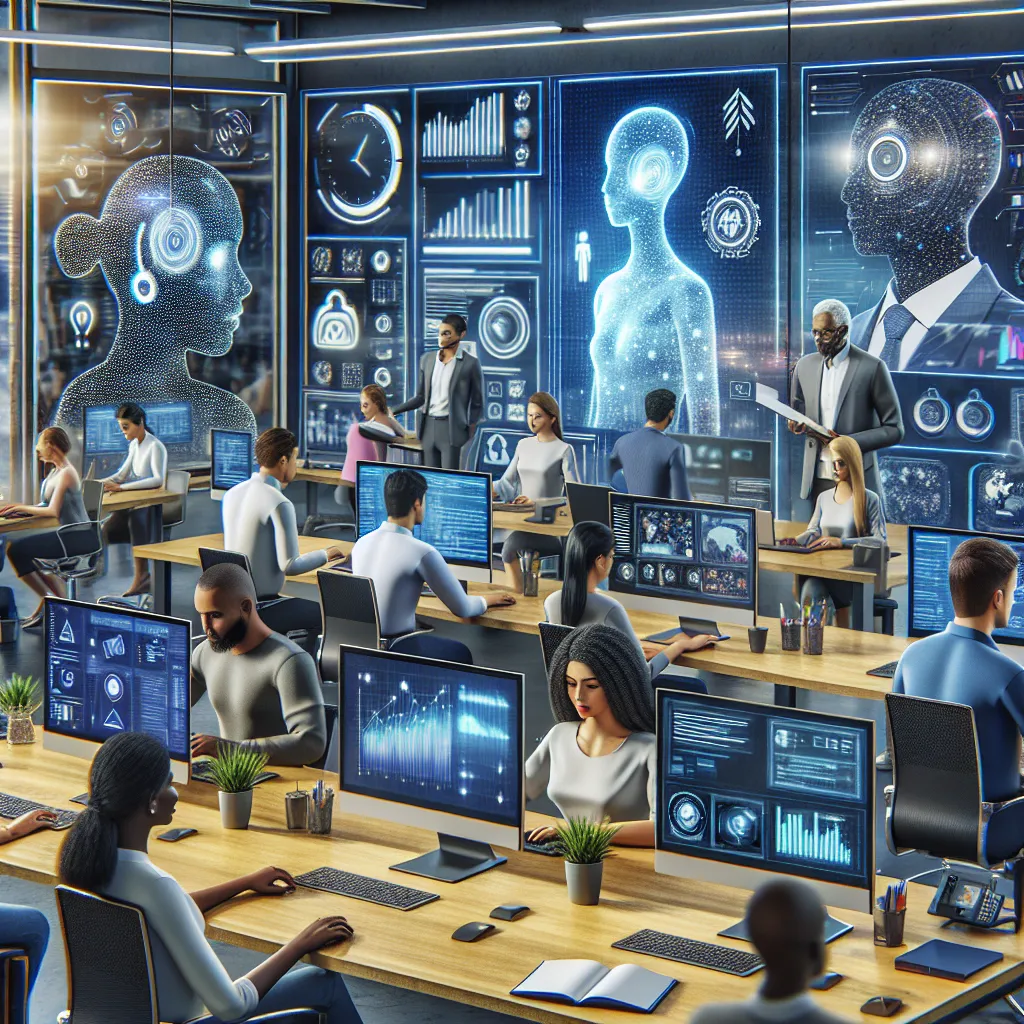The IELTS Reading section is a crucial component of the test, assessing your ability to comprehend complex texts and extract relevant information. Today, we’ll focus on a topic that has gained significant traction in recent years: “The role of technology in enhancing productivity.” This subject has appeared frequently in IELTS exams, reflecting its relevance in our rapidly evolving digital world. Given its importance in modern workplaces and its impact on global economies, there’s a high likelihood that you may encounter a similar theme in your upcoming IELTS test.
Table Of Contents
 Technology enhancing productivity
Technology enhancing productivity
IELTS Reading Practice Test
Reading Passage
The Technological Revolution in Workplace Productivity
In the 21st century, technology has become an indispensable tool in enhancing workplace productivity. From artificial intelligence to cloud computing, technological advancements are reshaping how businesses operate and how employees perform their tasks. This digital transformation has led to significant improvements in efficiency, collaboration, and overall output across various industries.
One of the primary ways technology boosts productivity is through automation. Repetitive and time-consuming tasks that once required hours of manual labor can now be completed in minutes using sophisticated software and machines. For instance, in manufacturing, robotic assembly lines have dramatically increased production rates while reducing errors. In offices, email filters and customer relationship management (CRM) systems automate communication and data entry, freeing up employees to focus on more complex, value-adding activities.
Cloud computing has revolutionized how teams collaborate and access information. With cloud-based platforms, employees can work on projects simultaneously from different locations, sharing real-time updates and feedback. This capability has been particularly crucial in the rise of remote work, allowing companies to maintain productivity even when staff are geographically dispersed. Moreover, cloud storage ensures that important documents and data are always accessible, reducing time wasted searching for information and minimizing the risk of data loss.
Artificial Intelligence (AI) and machine learning are at the forefront of the latest productivity enhancements. AI-powered analytics tools can process vast amounts of data to provide insights that inform better decision-making. In customer service, chatbots handle routine inquiries, allowing human agents to deal with more complex issues. Machine learning algorithms continuously improve these systems, making them more efficient over time.
Mobile technology has untethered workers from their desks, enabling productivity on the go. Smartphones and tablets, coupled with specialized apps, allow employees to respond to emails, attend virtual meetings, and access crucial information from anywhere. This flexibility not only increases the number of productive hours but also improves work-life balance, potentially leading to higher job satisfaction and, consequently, better performance.
However, the integration of technology in the workplace is not without challenges. The rapid pace of technological change can lead to a skills gap, where employees struggle to keep up with new tools and systems. Additionally, the constant connectivity enabled by technology can blur the lines between work and personal time, potentially leading to burnout if not managed properly.
To maximize the benefits of technology on productivity, companies must invest not only in new tools but also in training and support for their workforce. A well-implemented technological strategy should consider the human factor, ensuring that employees are comfortable with and capable of utilizing new systems effectively.
In conclusion, technology has become a cornerstone of workplace productivity in the modern era. Its ability to automate tasks, facilitate collaboration, provide data-driven insights, and offer flexibility has transformed how work is accomplished. As technology continues to evolve, its role in enhancing productivity is likely to grow, shaping the future of work in ways we are only beginning to understand. The challenge for businesses and individuals alike will be to harness these technological advancements while maintaining a balance that promotes sustainable productivity and employee well-being.
Questions
True/False/Not Given
- Automation has increased production rates in manufacturing.
- Cloud computing has made remote work less efficient.
- AI-powered chatbots can handle all types of customer inquiries.
- Mobile technology has increased the number of productive work hours.
- The integration of technology in the workplace is always smooth and without challenges.
Matching Headings
Match the following headings to the correct paragraphs in the passage. Write the correct number (i-viii) next to questions 6-10.
i. The double-edged sword of workplace technology
ii. Artificial Intelligence: The new frontier of productivity
iii. The rise of mobile productivity
iv. Automation: Streamlining repetitive tasks
v. Cloud computing: Revolutionizing collaboration
vi. The future of technology in productivity
vii. Training: The key to technological integration
viii. The importance of data security in cloud storage
- Paragraph 2 __
- Paragraph 3 __
- Paragraph 4 __
- Paragraph 5 __
- Paragraph 6 __
Sentence Completion
Complete the sentences below. Choose NO MORE THAN TWO WORDS from the passage for each answer.
- In manufacturing, __ __ have significantly increased production rates.
- Cloud-based platforms allow employees to work on projects __ from different locations.
- AI-powered analytics tools process large amounts of data to provide __ for better decision-making.
- The constant connectivity enabled by technology can lead to __ if not managed properly.
- To maximize the benefits of technology, companies must invest in training and __ for their workforce.
Answer Key and Explanations
-
True – The passage states, “In manufacturing, robotic assembly lines have dramatically increased production rates while reducing errors.”
-
False – The passage mentions that cloud computing has been “particularly crucial in the rise of remote work, allowing companies to maintain productivity even when staff are geographically dispersed.”
-
False – The passage indicates that chatbots handle “routine inquiries,” while human agents deal with “more complex issues.”
-
True – The text states, “This flexibility not only increases the number of productive hours but also improves work-life balance.”
-
Not Given – While challenges are mentioned, the passage doesn’t state that integration is always problematic.
-
iv – This paragraph discusses how automation streamlines repetitive tasks.
-
v – This paragraph focuses on how cloud computing has revolutionized collaboration.
-
ii – This paragraph is about AI and its role in enhancing productivity.
-
iii – This paragraph discusses mobile technology and its impact on productivity.
-
i – This paragraph highlights both benefits and challenges of workplace technology.
-
robotic assembly
-
simultaneously
-
insights
-
burnout
-
support
Common Mistakes and How to Avoid Them
-
Overlooking key phrases: Pay attention to qualifiers like “some,” “all,” or “most.” In question 3, the passage only mentions “routine inquiries” for chatbots, not all types.
-
Confusing True/False with Not Given: Remember, “Not Given” means the information is neither confirmed nor denied in the passage. For question 5, while challenges are mentioned, the text doesn’t state that integration is always problematic.
-
Mismatching headings: Ensure you read the entire paragraph to understand its main idea. Don’t be misled by a single sentence that seems to match a heading.
-
Exceeding word limits: In sentence completion questions, stick strictly to the word limit given. For question 11, “robotic assembly lines” exceeds the two-word limit, so “robotic assembly” is the correct answer.
-
Spelling errors: Even if you understand the correct answer, a spelling mistake can cost you marks. Double-check your spelling, especially for technical terms.
Vocabulary Focus
- Indispensable (adj): /ˌɪndɪˈspensəbl/ – absolutely necessary
- Automation (n): /ˌɔːtəˈmeɪʃn/ – the use of machines or computers instead of people to do a job
- Collaborate (v): /kəˈlæbəreɪt/ – to work together with someone else for a special purpose
- Dispersed (adj): /dɪˈspɜːst/ – spread over a wide area
- Artificial Intelligence (n): /ˌɑːtɪˈfɪʃl ɪnˈtelɪdʒəns/ – the development of computer systems able to perform tasks that normally require human intelligence
Grammar Spotlight
Pay attention to the use of present perfect tense in the passage, such as “technology has become” and “Cloud computing has revolutionized.” This tense is used to describe actions that started in the past and continue to have an impact in the present, which is particularly relevant when discussing ongoing technological advancements.
Tips for IELTS Reading Success
-
Practice active reading: Engage with the text by highlighting key points and making mental summaries as you read.
-
Improve your vocabulary: Regularly learn new words related to technology and productivity. This will help you understand complex texts more easily.
-
Time management: Allocate your time wisely. Spend about 20 minutes on each passage in the IELTS Reading test.
-
Skim and scan: Use these techniques to quickly locate specific information in the text.
-
Read the instructions carefully: Make sure you understand what each question is asking before you start answering.
-
Don’t leave any questions unanswered: Even if you’re unsure, make an educated guess. There’s no penalty for incorrect answers in IELTS.
Remember, success in IELTS Reading comes with consistent practice and familiarity with various question types. Keep practicing with diverse texts on different subjects to build your reading skills and confidence. Good luck with your IELTS preparation!
For more tips on improving your productivity, check out our article on the best ways to improve work productivity. If you’re interested in how technology is shaping our world beyond just productivity, you might find our piece on the role of technology in enhancing global connectivity insightful.


